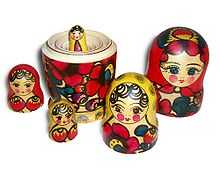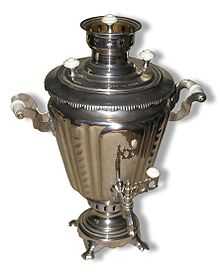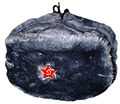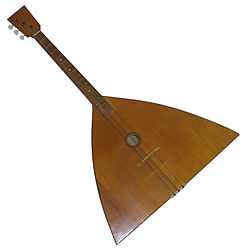Papakha
Papakha (Armenian: փափախ; Azerbaijani: papaq; Georgian: ფაფახი [pʰapʰaxi]; Russian: папа́ха; IPA: [pɐˈpaxə]), also known as astrakhan hat in English, is a male wool hat worn throughout the Caucasus and is of Azeri Turkic origin.[1][2][3][4]
The two Russian papakhas, one called a papaha, is a high fur hat, usually made of karakul sheep skin. The hat has the general appearance of a cylinder with one open side, and is set upon the head in such a way as to have the brim touch the temples, some of them comes with ear flaps which can fold up when not using them and unfold them down when using. The other called a kubanka, which is the same as the papaha, except shorter, and with no ear flaps.
Papaq are very common in Azerbaijan, Papaq is considered as part of man's attire and the saying goes that "if a man's hat falls from his head, it is like loosing his honor".[5][6][7][8][9] A famous story goes that Uzeyir Hajibeyov used to buy two tickets for Theater one for him and one for his papaq.[10] In Georgia, papakha are also mostly worn in mountainous regions of Pshavi, Khevi, Mtiuleti, and Tusheti. In Armenia where a man's hat is considered a very important part of his identity.[11] Papakha are also donned by the Chechens, Dagestanians, and other Caucasian tribes and were introduced to the Russian army following the campaigns in the Caucasus mountains, becoming an official part of the uniform in 1855 for the Cossacks, and, later, for the rest of the cavalry.
Russian and Soviet army uniforms
Shortly after the Russian revolution of 1917, papakhas were removed from the new Red Army uniform because of their association with the old Tsarist regime and the fact that many Cossack regiments of the Tsarist army fought against the Bolsheviks. During the Russian Civil War, many Bolshevik cavalrymen and officers (like Vasily Chapayev) wore papakhas or kubankas because many of them were cossacks and the hat had become a customary part of a cavalryman's costume.
Papakhas became part of the uniform again in 1935, but in 1941, were reserved exclusively for full colonels, generals and marshals, thus becoming a symbol of status and high rank. In 1994, they were once again removed from military use, allegedly upon the request of the wearers, who found the hat inefficient since the papakha is a relatively short hat that does not protect the ears well—this might have been acceptable in the mild climate of the Caucasus, but not in lower temperatures—and is not very wind-proof.
The act of removing the papakhas was seen in some quarters as an attempt of the Boris Yeltsin regime to abandon earlier Soviet traditions and symbolically demonstrate the country's commitment to a new political course. In 2005, papakhas were reinstalled.
-

Two Persian peasants wearing papakhas and two Persian officers gambling, between 1876 and 1933, Brooklyn Museum
-

Leonid Brezhnev (right) wearing a papakh and Gerald Ford wearing an ushanka, 1974 in Vladivostok
-

Armenian military commander Andranik wearing a papakhi
-
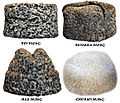
Differnt types of Azerbajani Papaqs
See also
References
- ↑
- ↑
- ↑ http://asia.rbth.com/arts/2015/01/06/head_high_in_a_papakha_the_history_of_a_hat_that_can_never_be_removed_42153.html
- ↑ http://memim.com/papakha.html
- ↑
- ↑
- ↑ http://www.visions.az/art,363/
- ↑ http://azeri.ru/papers/echo-az_info/62846/
- ↑ http://azeri.ru/az/cultur/azerbaydjanskiy_nacionalnyy_kostyum/
- ↑ http://news.day.az/society/342082.html
- ↑ Jill Condra (2013). Encyclopedia of National Dress: Traditional Clothing Around the World. ABC-CLIO. p. 39. ISBN 978-0-313-37636-8.
External links
| Wikimedia Commons has media related to Papakhi. |
| ||||||||||||||||||||||||||||||
